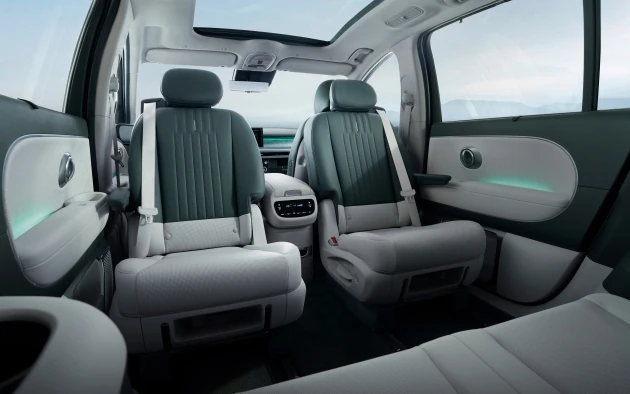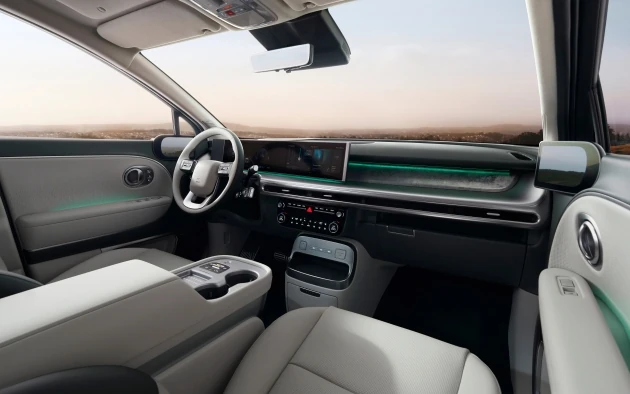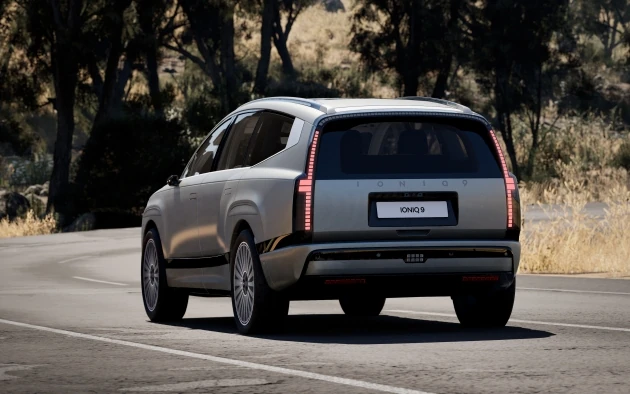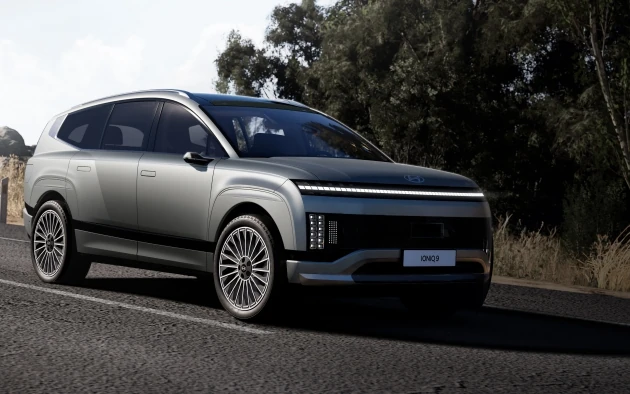South Korea car giant Hyundai has unveiled a new EV, a three-row, 7-seat all-electric SUV called the Ioniq 9 that features expansive interior space that will sit at the top of their EV lineup.
The Ioniq 9 was unveiled in Los Angeles and will be on display at the LA Auto Show from November 22 before going on sale in Korea and the United States in the first half of 2025.
Hyundai is planning to roll out the Ioniq 9 in Europe and other markets later. There is no further information available about pricing or an Australian release date yet, and detailed specifications will be unveiled closer to specific market launches.
The Ioniq 9 is based on Hyundai’s Electric-Global Modular Platform (E-GMP) and includes many of the features found in its Ioniq 5 and Ioniq 6 vehicles, as well as some innovative new features making their debut in this flagship vehicle. It will likely compete with the Kia EV9.
Relaxation seats in the first and second rows of the Ioniq 9 can fully recline and offer a leg rest for optimal comfort. These seats also include a Dynamic Touch Massage function, which uses pressure and vibration to stimulate blood flow and circulation, reducing fatigue on long drives.

Ioniq 9 introduces second-row swivelling seats, allowing the second- and third-row occupants to face each other when the vehicle is stationary. This feature is available in selected markets only though, with Australia missing out on the same feature in sister brand Kia’s equivalent flagship EV9.
Between the front row seats is a new Universal Island 2.0 sliding centre console, which can be moved by up to 190 mm, allowing walk-through front-row seating and easy access by first and second row occupants. The console also includes 5.6 L of storage in the upper tray and 12.6 L of storage in the lower sliding tray.

Luggage space in the Ioniq 9 is up to 620 litres with all three rows in place, expanding to 1,323 L with the third-row folded flat. These figures are much higher than the VDA measurements Kia provides for their EV9, which are 333 L with 7 seats up and 828 L with 5 seats in place, so it will be interesting to compare storage space of the two vehicles in person.
Three Ioniq 9 variants have been revealed, all featuring the same 110.3 kWh NCM lithium-ion battery. The base Long-Range RWD model is powered by a 160 kW rear motor, capable of accelerating the vehicle from 0-100 km/h in 9.4 seconds and providing an estimated WLTP range of up to 620 km.
A Long-Range AWD model adds a second 70 kW front motor, cutting 0-100 km/h acceleration to 6.7 seconds while the Long-Range Performance utilises dual 160 kW motors and can hit 100 km/h in just 5.2 seconds. Range estimates have not been provided for AWD variants, but are expected to be lower than 620 km.
The Ioniq 9 runs on an 800 V architecture and can DC fast charge from 10-80% in 24 minutes when connected to a 350 kW charger. Vehicle to load (V2L) is provided via an outlet in the cargo area and high-output 100 W USB-C ports in all three rows are powered directly from the main battery pack for uninterrupted use.
Design wise, Ioniq 9 features a sleek ‘Aerosthetic’ exterior, much more rounded than the boxy Kia EV9. IONIQ 9’s silhouette is defined by a smooth, curved roofline, creating a streamlined aerodynamic profile and a low drag coefficient of just 0.259 Cd when fitted with the optional digital side mirrors.

The Ioniq 9 is also the first Hyundai model to eliminate the roof antenna, dividing its functions between the windshield cover, instrument panel and tailgate glass, contributing to its advanced minimalistic design.
The European models can tow up to 2,500 kg, matching the capability of Kia EV9 dual-motor variants available in Australia. The Ioniq 9 is also equipped with a Terrain Traction Control System for rough roads plus an AI-based Auto Terrain Mode that recognises the road surface and automatically selects the optimal driving mode.

Hyundai IONIQ 9 specifications
| Variant | Long-Range RWD | Long-Range AWD | Performance AWD | ||
| Battery size and chemistry | 110.3 kWh, Nickel Manganese Cobalt (NCM) | ||||
| Range (estimated) | 620 km WLTP, with 19-inch wheels | TBA | TBA | ||
| Driven wheels | Rear-wheel drive | All-wheel drive | |||
| Power / Torque | 160 kW / 350 Nm | 230 kW / 605 Nm | 320 kW / 700 Nm | ||
| Charging time | 350 kW DC (10 – 80 %) – 24 minutes | ||||
| Exterior dimensions | Length: 5,060 mm Width: 1,980 mm Height: 1,790 mm Wheelbase: 3,130 mm |
||||
| Storage space | Frunk: 88 L (RWD), 52 L (AWD) Boot, 7 seats up: 620 L Boot 5 seats up: 1,323 L |
||||
| Tyres and wheels | 255/60R19 (19″), 275/50R20 (20″), 285/45R21 (21″) | ||||
| Exterior colours | NEW: Celadon Gray Matte/Metallic, Ionosphere Green Pearl, Sunset Brown Pearl, and Cosmic Blue Pearl.ALSO: Abyss Black Pearl, Serenity White Pearl, Snow White Pearl, Cyber Gray Metallic, Atlas White Matte, Ecotronic Gray Matte, Nocturne Gray Matte/Metallic, Gravity Gold Matte, Ultimate Red Metallic, and Biophilic Blue Pearl |
||||
| Interior colours | Obsidian Black, Dark Pebble Gray + Dove Gray (two-tone), Obsidian Black + Dove Gray (two-tone), Dark Teal + Dove Gray (two-tone), Mud Gray + Creamy Beige (two-tone), Cognac Brown + Creamy Beige (two-tone), and Dark Wine + Dove Gray (two-tone) |
||||

Tim has 20 years experience in the IT industry including 14 years as a network engineer and site reliability engineer at Google Australia. He is an EV and renewable energy enthusiast who is most passionate about helping people understand and adopt these technologies.

